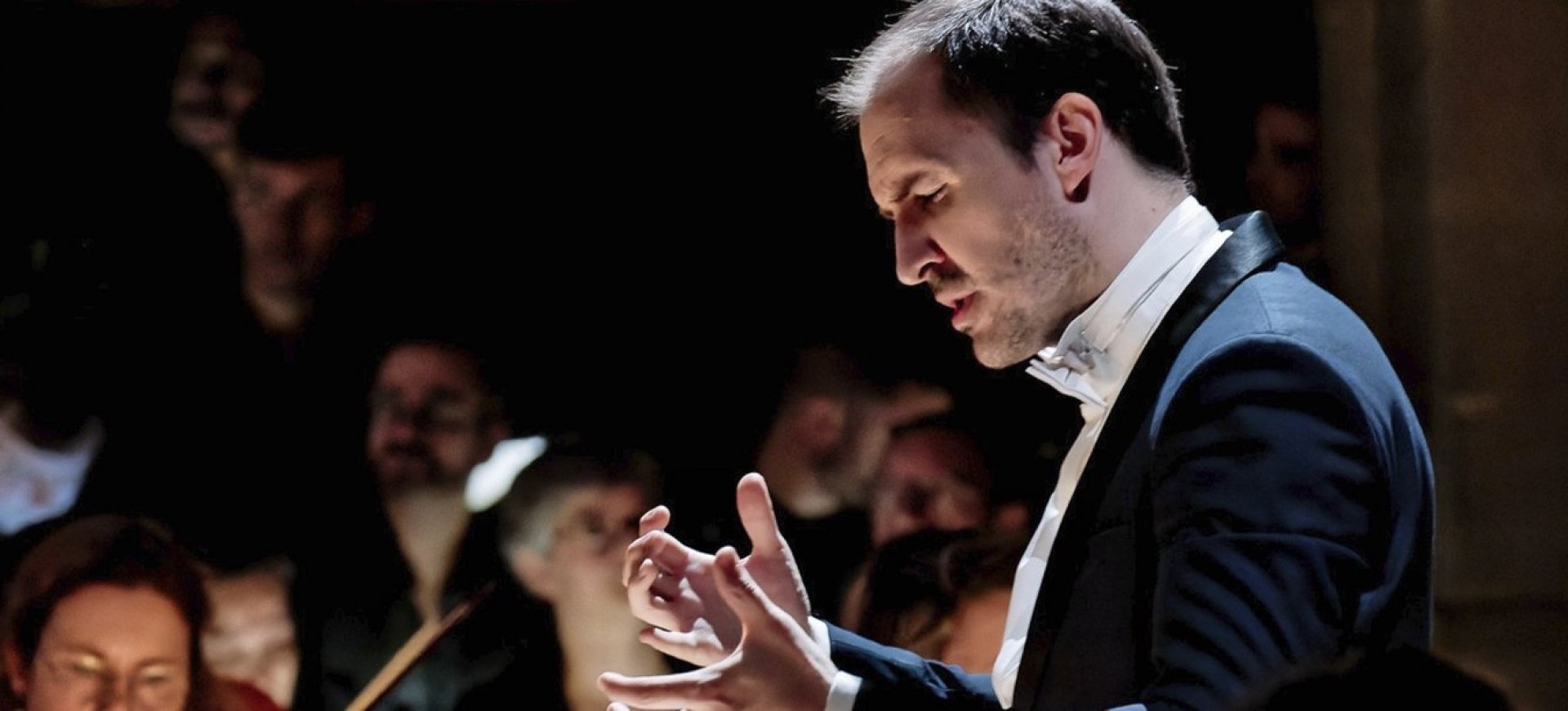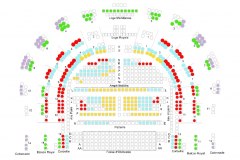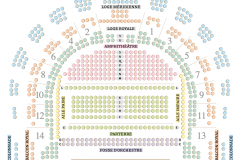Donizetti: La Fille Du Régiment
Mo | Tu | We | Th | Fr | Sa | Su |
Opéra-comique in two acts, with libretto by Jules-Henri Vernoy de Saint-Georges and Jean-François Bayard, first performed in Paris in 1840.
New Royal Opera Production.
Show in Italian with French and English surtitles.
Opera in staged version
Synopsis
Time: The Napoleonic Wars, early 19th century
Act 1
War is raging in the Tyrols and the Marquise of Berkenfield, traveling in the area, is alarmed to the point of needing smelling salts to be administered by her faithful steward, Hortensius. While a chorus of villagers express their fear, the Marquise does the same: Pour une femme de mon nom / "For a lady of my family, what a time, alas, is wartime". As the French are seen moving away, all express relief. Suddenly, provoking the fear of the remaining women, who scatter, Sergeant Sulpice of the Twenty-First Regiment of the French army (in the Italian version it is the Eleventh) arrives and assures everyone that the regiment will restore order.
Marie, the vivandière (canteen girl) of the Regiment enters, and Sulpice is happy to see her (duet: Sulpice and Marie: Mais, qui vient? Tiens, Marie, notre fille / "But who is this? Well, well, if it isn't our daughter Marie"). After he questions her about a young man she has been seen with, she identifies him as Tonio, a Tyrolean (in the Italian version: Swiss). At that moment, Tonio is brought in as a prisoner because he has been seen prowling around the camp. Marie saves him from the soldiers, who demand that he die, by explaining that he saved her life when she nearly fell while mountain-climbing. All toast Tonio, who pledges allegiance to France, and Marie is encouraged to sing the regimental song (aria: Chacun le sait, chacun le dit ... Le beau vingt-et-unième! / "Everyone knows it, everyone says it ... The beautiful 21st"). Sulpice leads the soldiers off, taking Tonio with them, but he runs back to join her. She quickly tells him that he must gain the approval of her "fathers": the soldiers of the Regiment, who found her on the battlefield as an abandoned baby and adopted her. He proclaims his love for her (aria, then love duet with Marie: Depuis l'instant où, dans mes bras / "Ever since that moment when you fell and / I caught you, all trembling in my arms"), and the couple express their love for each other.
At that point, Sulpice returns, surprising the young couple, who leave. The Marquise arrives with Hortensius. Initially afraid of the soldier, she is calmed by him. The Marquise explains that they are trying to return to her castle and asks for an escort. Hearing the name Berkenfield, Sulpice immediately recognizes it from a letter found with Marie as an infant. It is discovered that Marie is actually the Marquise's long-lost niece. Marie returns and is surprised to be introduced to her aunt. The Marquise commands that Marie accompany her and learn to be a proper lady. Marie bids farewell to her beloved regiment just as Tonio enters announcing that he has enlisted in their ranks (aria: Ah! mes amis, quel jour de fête / "Ah, my friends, what an exciting day"). When he proclaims his love for Marie, the soldiers are horrified, but agree to his pleading for her hand. However, they tell him that she is about to leave with her aunt (Marie, aria: Il faut partir / "I must leave you!"). In a choral finale, she leaves with the Marquise and Tonio is enraged.
Act 2
Marie has been living in the Marquise's castle for several months. In a conversation with Sulpice, the Marquise describes how she has sought to modify Marie's military manners and make her a lady of fashion, suitable to be married to her nephew, the Duke of Crakenthorp. Although reluctant, Marie has agreed and Sulpice is asked to encourage her. Marie enters and is asked to play the piano, but appears to prefer more martial music when encouraged by Sulpice and sings the regimental song. The Marquise sits down at the piano and attempts to work through the piece with Marie, who becomes more and more distracted and, along with Sulpice, takes up the regimental song.
Marie is left alone (aria: Par le rang et par l'opulence / "They have tried in vain to dazzle me"). As she is almost reconciled to her fate, she hears martial music and is joyously happy (cabaletta: Oh! transport! oh! douce ivresse / "Oh bliss! oh ectasy!"), and the regiment arrives. With it is Tonio, now an officer. The soldiers express their joy at seeing Marie, and Marie, Tonio and Sulpice are joyfully reunited (trio, Marie, Sulpice, Tonio: Tous les trois réunis / "We three are reunited"). Tonio says he has just learned a secret, via his uncle the burgermeister, that he cannot reveal.
The Marquise enters, horrified to see soldiers. Tonio asks for Marie's hand, explaining that he risked his life for her (aria, Tonio: Pour me rapprocher de Marie, je m'enrôlai, pauvre soldat / "In order to woo Marie, I enlisted in the ranks"), but she dismisses him scornfully. Tonio reveals that he knows that the Marquise never had a niece. She orders him to leave and Marie to return to her chambers; after they leave, the Marquise confesses the truth to Sulpice: Marie is her own illegitimatedaughter. Under the circumstances, Sulpice promises that Marie will agree to her mother's wishes.
The Duchess of Crakenthorp, her son the groom-to-be, and the wedding entourage arrive at the Marquise's castle. Marie enters with Sulpice, who has told her that the Marquise is her mother. Marie embraces her and decides she must obey. But at the last minute the soldiers of the Regiment storm in (chorus: soldiers, then Tonio: Au secours de notre fille / "Our daughter needs our help") and reveal that Marie was a canteen girl. The wedding guests are offended by that, but then impressed when Marie sings of her debt to the soldiers (aria, Marie: Quand le destin, au milieu de la guerre / "When fate, in the confusion of war, threw me, a baby, into their arms"). The Marquise is deeply moved, admits she is Marie's mother, and gives her consent to Marie and Tonio's marriage, amid universal rejoicing (final chorus: Salut à la France! / "Hurrah for France! For happy times!").
Program and cast
VIP CATEGORY: Best seats in house with complimentary glass of champagne and programme.
PRESTIGE CATEGORY: Excellent seats with complimentary glass of champagne and programme.
2h40 entracte inclus
Gwendoline Blondeel: Marie
Patrick Kabongo: Tonio
Jean-François Lapointe: Sulpice
Éléonore Pancrazi: The Marquise of Berkenfield
Jean-Gabriel Saint-Martin: Hortensius
Flore Royer*: The Duchess of Crakentorp
NN A corporal
Attila Varga-Tóth*: A farmer, A notary
*Member of the Royal Opera Academy
Chœur de l’Armée française
Chœur de l’Opéra Royal
Orchestre de l’Opéra Royal
Under the high patronage of Aline Foriel-Destezet
Gaétan Jarry: Conductor
Jean-Romain Vesperini: Director
Christian Lacroix: Costumes
Roland Fontaine: Stage sets
Christophe Chaupin: Lumières
Claire Manjarres: Assistant director
Palace of Versailles Opera Theater
Royal Opera
The Royal Opera of Versailles, located in the grounds of the Castle, one of the major opera houses.
The opening of the opera house at Versailles brought to a close a process of planning, projects and designs that had lasted for nearly a century. While the Royal Opera was finally built towards the end of the reign of Louis XV, it had been envisaged since as early as 1682, the year when his predecessor Louis XIV took up residence at Versailles. The King had commissioned Jules Hardouin-Mansart and Vigarani to draw up plans for a ballet theatre. Mansart shrewdly decided on a position at the far end of the new wing that was to be built over the coming years: the nearby reservoirs for the gardens’ fountains could be used to fight any fire that might break out, while the sloping ground on that part of the site would allow provision of the necessary technical spaces below the stage without major excavation work. So cleverly-chosen, indeed, was the planned location that none of Mansart’s successors ever questioned it.
Major building work was already under way in 1685, but was soon interrupted because of the wars and financial difficulties which beset the later part of the king’s reign. Louis XV in his turn was long put off by the huge expense involved in the project. As a result, for almost a century the French court was forced to put up with a makeshift theatre installed below the Passage des Princes. When a grand opera was required, with a large cast and complicated stage machinery, a temporary theatre would be built in the stables of the Grande Ecurie, with the entire structure being demolished once the performances were over. This temporary solution was adopted, for instance, during the celebrations of the Dauphin’s wedding in February 1745, but its inconvenience was so starkly obvious that Louis XV finally resolved to build a permanent theatre, entrusting its design to his first architect, AngeJacques Gabriel.
The process of actually building the new theatre, however, was to take over twenty years. During this lengthy period of construction Gabriel, who had studied the leading theatres of Italy, in particular Vicenza, Bologna, Parma, Modena and Turin, presented a series of different designs to his royal patron, none of which was accepted. Only in 1768, faced with the forthcoming successive marriages of his grandchildren, did the king finally give the order for work to commence. Building progressed steadily and the new opera house was completed in twenty-three months, ready for its inauguration on the 16th of May 1770, the day of the Dauphin’s marriage to the Archduchess Marie-Antoinette, with a performance of Persée by Quinault and Lully.
Royal Chapel
This extraordinary two-level palatine chapel was built by Jules Hardouin Mansart between 1699 and 1708 and completed by Robert de Cotte in 1710.
The paintings on the vaulted ceiling by Antoine Coypel, Charles de la Fosse and Jean Jouvenet, as well as the lavish decoration fashioned by a team of sculptors working for Louis XIV, depict a number of Old and New Testament scenes. Facing the royal gallery is the remarkable organ, created by Robert Clicquot, the King's organ builder, which was first played on Easter Sunday 1711 by François Couperin.
Even though Hardouin-Mansart did not witness the completion of the chapel, he was the one who had dictated the major aspects of the architecture and decor: a ground floor with a nave, aisles and ambulatory, and an upper floor with galleries, a harmonious combination of white and gold contrasting with the polychromatic marble floor and paintings on the vaulted ceiling, all combining to create an original space with references to both gothic architecture and baroque aesthetics.
Every day, generally at 10 a.m., the court would attend the King's mass. The King would sit in the royal gallery, surrounded by his family, while the ladies of the court would occupy the side galleries. The "officers" and the public would sit in the nave. The King would only descend to the ground floor for important religious festivals when he would take communion, for Order of the Holy Spirit ceremonies and for the baptisms and weddings of the Children of France, which were celebrated there between 1710 and 1789. Above the altar, around the Cliquot organ played by the greatest virtuosos of their age, including François Couperin, the Chapel Choir, renowned throughout Europe, would sing motets throughout the entire service, every day.
The Orangerie gardens
From May to October, orange trees and other shrubs are taken out of the Parterre Bas of the Orangerie gardens. At the center of this parterre, there is a large circular pool surrounded by six sections of lawn.
Orangerie
A great stone cathedral within a formal garden, The Orangerie is both a royal and magical place.
Built between 1684 and 1686 by Jules Hardouin-Mansart to house and protect precious trees and shrubs during the Winter, this extraordinarily large building is located beneath the parterre du Midi (South flowerbed), for which it acts as a support. Two monumental staircases, known as "les Cent Marches" (the hundred steps), frame the Orangerie's three galleries, which overlook the parterre where, during the Summer, more than 1,200 exotic trees are arranged.

 EN
EN DE
DE IT
IT FR
FR ES
ES RU
RU JP
JP RO
RO
 Seating plan
Seating plan 
